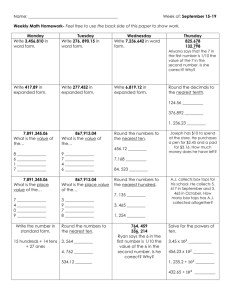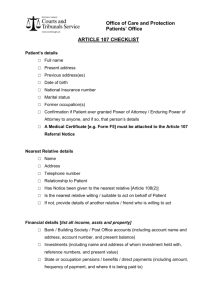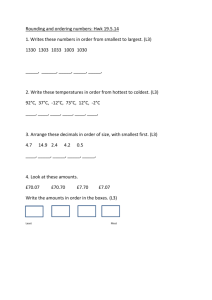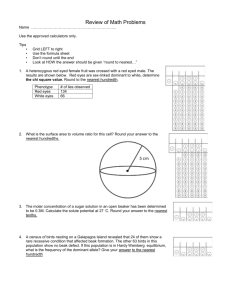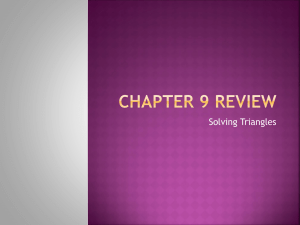Year 5 Teaching Sequence 2 – Ordering numbers
advertisement
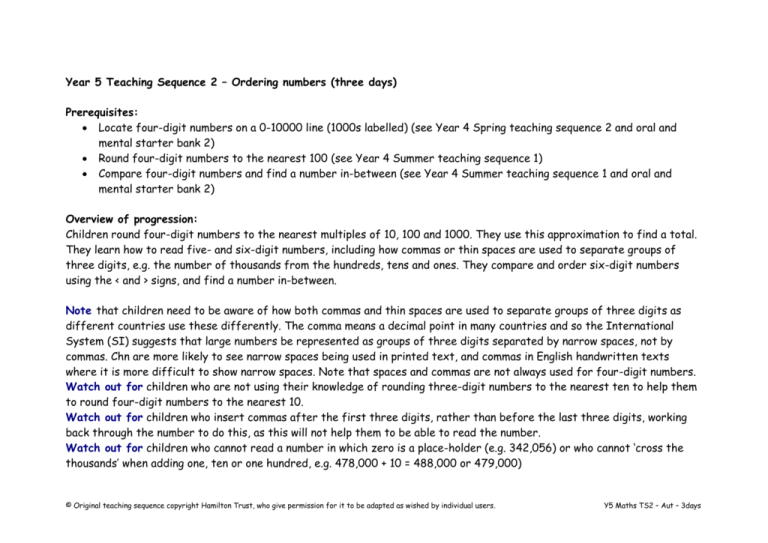
Year 5 Teaching Sequence 2 – Ordering numbers (three days) Prerequisites: Locate four-digit numbers on a 0-10000 line (1000s labelled) (see Year 4 Spring teaching sequence 2 and oral and mental starter bank 2) Round four-digit numbers to the nearest 100 (see Year 4 Summer teaching sequence 1) Compare four-digit numbers and find a number in-between (see Year 4 Summer teaching sequence 1 and oral and mental starter bank 2) Overview of progression: Children round four-digit numbers to the nearest multiples of 10, 100 and 1000. They use this approximation to find a total. They learn how to read five- and six-digit numbers, including how commas or thin spaces are used to separate groups of three digits, e.g. the number of thousands from the hundreds, tens and ones. They compare and order six-digit numbers using the < and > signs, and find a number in-between. Note that children need to be aware of how both commas and thin spaces are used to separate groups of three digits as different countries use these differently. The comma means a decimal point in many countries and so the International System (SI) suggests that large numbers be represented as groups of three digits separated by narrow spaces, not by commas. Chn are more likely to see narrow spaces being used in printed text, and commas in English handwritten texts where it is more difficult to show narrow spaces. Note that spaces and commas are not always used for four-digit numbers. Watch out for children who are not using their knowledge of rounding three-digit numbers to the nearest ten to help them to round four-digit numbers to the nearest 10. Watch out for children who insert commas after the first three digits, rather than before the last three digits, working back through the number to do this, as this will not help them to be able to read the number. Watch out for children who cannot read a number in which zero is a place-holder (e.g. 342,056) or who cannot ‘cross the thousands’ when adding one, ten or one hundred, e.g. 478,000 + 10 = 488,000 or 479,000) © Original teaching sequence copyright Hamilton Trust, who give permission for it to be adapted as wished by individual users. Y5 Maths TS2 – Aut – 3days Objectives: Order a set of numbers up to 1 million Compare numbers up to 1 million, find a number in-between, use < and > signs Round four-digit numbers to the nearest 10, 100 or 1000 Whole class Group activities Paired/indiv practice Resources Sketch a line from 5570 and 5580 and ask children to copy it onto their whiteboards. Think of a number that is between 5570 and 5580 and mark it on your line. Which number is it closer to? Which is the nearest multiple of ten? Ask a few children to show their boards and to say which multiple of ten their number rounds to. Now think of a different number that will round to 5580 when you round it to the nearest ten. Write it on your board, show me. Now write a number that will rounds to 5570 when you round it to the nearest multiple of ten. Call out four-digit numbers and ask children which multiple of 10 they are closer to. They write the correct multiple of 10 on their whiteboards. Now sketch a line from 5500 to 5600. Work with a partner to think of a number between 5500 and 5600 which will round to 5500 when rounded to the nearest 100. Mark it on your line. Share children’s whiteboards. What would we round 5550 to? Explain that we would round 5550 up to 5600. Now show me a number closer to 5600 than 5500. Call out four-digit numbers and ask children which multiple of 100 they are closer to. They write the correct multiple of 100 on their whiteboards. Group of 4-5 children Sketch a line on the flipchart from 4600 to 4700. Ask a child to think of a number between the two and to mark it on the line but not to write the number. Ask children to discuss in pairs what the mystery number might be and to write an estimate on their whiteboards. Tell children that they can choose two multiples of ten for you to put on the line. When they have reached an agreement (e.g. 4650 and 4660) ask the child at the flipchart to mark on where these two numbers might be. Do you want to change your estimate? Ask the child to reveal the mystery number and say how s/he decided where to mark the number. Repeat with another child. Repeat, but this time with 5000 at one end of the line and 6000 at the other, asking a child to mark a number in between. After a while say that they can choose two multiples of 100 to place on the line (e.g. 5500 and 5600). Ask children to write their estimates on their boards. Could the number be 5525? Why not? Draw out that the number is closer to 5600 Children work in pairs to shuffle a pack of 0-9 digit cards, and take four to make a four-digit number. They discuss which two multiples of ten it lies between, sketch a line between the two multiples of 10 and mark on the number they made. They ring the nearest multiple of 10. They discuss which two multiples of hundred the number lies between, sketch a line between the two multiples of 100 and mark on the number they made. They ring the nearest multiple of 100. They discuss which two multiples of hundred it lies between, sketch a line between the two multiples of 1000 and mark on the number they made. They ring the nearest multiple of 1000. Repeat with other four-digit numbers. Easier: Children have a 3000-4000 landmarked line (100s labelled). 0-9 digit cards 3000-4000 landmarked line, 100s labelled (see resources) © Original teaching sequence copyright Hamilton Trust, who give permission for it to be adapted as wished by individual users. Y5 Maths TS2 – Aut – 3days Draw a line from 5000 to 6000 and mark on a number in between. Which multiple of one thousand is it closer to? Share children’s’ boards. Now think of a new number which will round to 5000 when rounded to the nearest thousand. Now think of a number that will round to 6000. Display a table of distances between places around the world (see resources). Show how to use this table to find the distance from London to Delhi. What multiples of ten lie either side of 5907? Sketch a line on your whiteboards to show 5907 between 5900 and 5910. So what is 5907 to the nearest 10 miles? To the nearest 100 miles? Sketch a number line on your whiteboards to show this. And to the nearest 1000 miles? Sketch a line to show this. Repeat with two four-digit distances. What is the shortest distance between two cites on the table? And the greatest? The closest city to London? And the furthest away? You might want to show some of these cities on a globe so that chn appreciate where they are. Look where Tokyo and Sydney are in relation to London. Approximately how far do you think it is around the widest part of the Earth? (Approximately 25,000 miles.) than to 5500 for example. Ask the child to reveal the answer. If you have a number which rounds to 5600 not 5550, you made a good estimate. Easier: Think of, and mark the numbers on the line yourself rather than asking a child, and then progress to asking a pair to do this. If necessary begin with three-digit numbers between 600 and 700 before moving onto four-digit numbers between 4600 and 4700. Group of 4-5 children Display the table of distances. If someone lived in Tokyo and travelled to every city on the table and back in between each trip, roughly how far would that person travel? What could we do to help us answers this? Round each to the nearest 1000 and add up the number of 1000s. What do we need to do now? Agree that you need to double the total as the person came home in-between. So rounding is helpful when we want an approximate answer. Harder: Plan a world trip. Estimate the distance travelled from Tokyo to Delhi, onto Frankfurt and so on, finding each distance on the table and rounding to the nearest 1000. They make at least four numbers between 3000 and 4000 and mark them on the line. They write the four numbers underneath, and write the nearest multiple of 10, 100 and 1000 at the side of each. Ask chn to choose at least 6 fourdigit distances from the table (see resources) and to round them to the nearest 10, 100 and 1000 miles, sketching number lines to show where the distances lie between neighbouring multiples of 10, 100 and 1000. Easier: Chn choose 3 three-digit numbers to round to the nearest 10 and 100, and then choose 3 fourdigit numbers to round to the nearest 10, 100 and 1000. Harder: Chn also include a few five-digit distances. Challenge chn to think of a four-digit number that would be rounded up when rounding to the nearest 10, down when rounding to the nearest 100 and up when rounding to the nearest 1000 (e.g. 6926). © Original teaching sequence copyright Hamilton Trust, who give permission for it to be adapted as wished by individual users. Table of distance between cities from around the world (see resources) Globe Y5 Maths TS2 – Aut – 3days Write 1,351,468 and 1 351 468 on the board. Ask chn to discuss with their maths partners how to read these two numbers. Take feedback and agree what the number is and how it is said. Discuss how in the first way of recording the number, commas are used to group digits in groups of three when we write big numbers, and often thin spaces are used when numbers are printed as in the second way of writing the same number. Explain how the grouping helps us to read the numbers. Cover the first three digits, and read the number as one thousand, four-hundred and sixty-eight. Now reveal the digit 5. What is the number now? Fiftyone thousand, and four-hundred and sixty-eight, the 5 and 1 before the last three digits tells us how many thousands there are. Reveal the 3, and now three-hundred and fifty-one thousand, and four-hundred and sixty-eight. The digits 351 tell us how many thousands there are. Finally reveal the digit 1, and now one million, three-hundred and fifty-one thousand, and four-hundred and sixtyeight. Write the number which comes before this number on your whiteboards, and the next three numbers. Write four other seven-digit numbers on the board and ask chn to work out how to read them. Group of 4-5 children Display the following table: Planet Diameter in miles Distance to the Sun in miles Earth 7,926 92,957,100 Jupiter 88,846 483,632,000 Mars 4,222 141,635,300 Mercury 3,032 35,983,610 Neptune 30,778 2,798,842,000 Saturn 74,898 888,188,000 Uranus 31,763 1,783,950,000 Venus 7,521 67,232,360 Chn work in pairs to each roll a 0-9 dice six times to generate two sixdigit numbers. They decide which is larger and write the corresponding equalities. They record a number in-between. After they have played the game at least five times, they write all the numbers in a list from the smallest to the largest. Harder: Chn record the number in between using < or > signs, e.g. 234,739 < 240,000 < 241,827. Table as opposite 0-9 dice Which is the smallest planet? And the biggest? Write a list of planets in order of size. What is the diameter of Mercury to the nearest 10 miles? 100 miles? 1000 miles? Repeat rounding the diameters of other planets. Which planet is closest to the Sun? And furthest away? Write a list of planets in order of their distance away from the Sun. © Original teaching sequence copyright Hamilton Trust, who give permission for it to be adapted as wished by individual users. Y5 Maths TS2 – Aut – 3days

